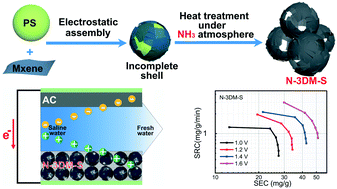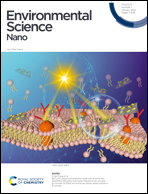Interconnected N-doped MXene spherical shells for highly efficient capacitive deionization†
Abstract
MXenes have been considered as promising electrode materials for capacitive deionization (CDI). However, the availability of space for trapping and storing ions is usually inhibited in Mxene-based assemblies due to their special lamellar structure, which affects their desalination performance. Herein, a kind of N-doped Ti3C2Tx electrode with a unique interconnected porous structure (N-3DM-S) is designed to improve the active site accessibility of the electrodes. The Ti3C2Tx shell layers with flaws are prepared on spherical sacrificial templates, which then lead to the formation of an interconnected N-doped porous architecture upon the heat treatment under an NH3 atmosphere. The interconnected porous feature improves the availability of electrode materials, while the doping of nitrogen further enhances the accessibility of the electrode to electrolyte in addition to the chemical and electrochemical properties. As a result, the as-obtained N-3DM-S samples with more valid surface active sites exhibit excellent CDI performance compared to the control samples with isolated pore structure and the ones without N-doping. In particular, the optimal CDI capacities of N-3DM-S electrodes can reach up to 53 ± 2 mg g−1 in aqueous NaCl of 5000 mg L−1 at 1.6 V. Moreover, such N-3DM-S electrodes exhibit good regeneration stability as well, indicating their potential applications in the field of desalination.



 Please wait while we load your content...
Please wait while we load your content...